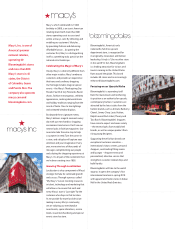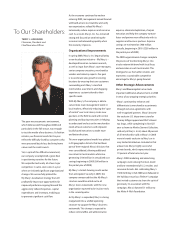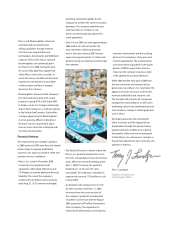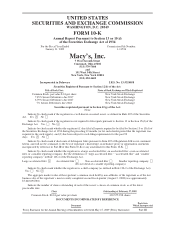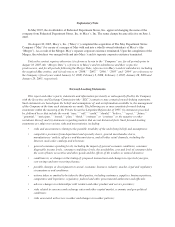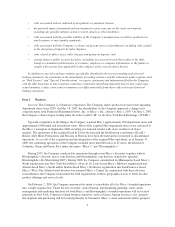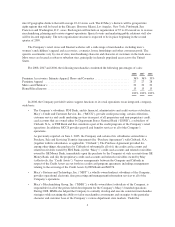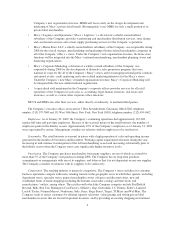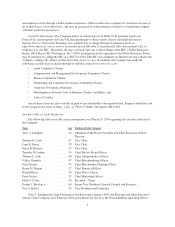Macy's 2008 Annual Report Download - page 3
Download and view the complete annual report
Please find page 3 of the 2008 Macy's annual report below. You can navigate through the pages in the report by either clicking on the pages listed below, or by using the keyword search tool below to find specific information within the annual report.
TERRY J. LUNDGREN
Chairman, President and
Chief Executive O cer
To Our Shareholders:
The poor macroeconomic environment,
which deteriorated throughout 2008 and
particularly in the fall season, was enough
to test the mettle of any business. As fashion
retailers, our fi nancial results for the year
refl ect the diffi culty faced by consumers who
were pressured by job loss, declining home
values and the credit crunch.
Yet, in spite of this diffi cult environment,
our company accomplished a great deal
in positioning ourselves for the future.
We outperformed nearly all of our major
competitors in same-store sales in a year
when we initiated signifi cant organizational
changes. We successfully piloted the
My Macy’s localization strategy that will
profoundly impact our opportunities for
improved performance going forward. We
aggressively reduced expenses, capital
expenditures and inventory, enabling us
to generate signifi cant cash fl ow.
As the economy continued to weaken
entering 2009, management moved forward
with bold actions to streamline and unify
our organization, rollout My Macy’s
nationwide, reduce expenses and conserve
cash. As a result, Macy’s, Inc. has remained
strong and focused on weathering the
recession and rebounding quickly when
the economy improves.
Organizational Improvements
In spring 2008, Macy’s, Inc. began piloting
a new localization initiative – My Macy’s –
developed based on customer research,
as well as input from Macy’s store managers,
senior company executives, merchandise
vendors and industry experts. Our goal
is to accelerate sales growth in existing
locations by ensuring that core customers
surrounding each Macy’s store fi nd
merchandise assortments and shopping
experiences custom-tailored to their
specifi c needs.
With My Macy’s, the company is able to
concentrate more management talent in
local markets, eff ectively reducing the “span
of control” over local stores; create new
positions in the fi eld to work with central
planning and buying executives in helping
to understand and act on the merchandise
needs of local customers; and empower
locally-based executives to make more
and better decisions.
This new organizational model was piloted
in 20 geographic districts that had been
part of three regional Macy’s divisions that
were consolidated, allowing additional
investment in local markets while also
generating $100 million in annualized cost
savings beginning in 2009 ($60 million in
the partial year of 2008).
My Macy’s started showing results earlier
than anticipated. So early in 2009, the
company announced that the My Macy’s
structure would be rolled out to all
Macy’s stores nationwide, with the new
organization expected to be in place early
in the second quarter.
As My Macy’s is expanded, Macy’s is being
reorganized into a unifi ed operating
structure to support the Macy’s business
nationwide. This change is expected to
reduce central offi ce and administrative
expense, eliminate duplication, sharpen
execution and help the company to move
faster and partner more eff ectively with its
suppliers and business partners. Expense
savings are estimated at $400 million
annually, beginning in 2010 ($250 million in
the partial year of 2009).
The 2009 organizational changes complete
the process of transforming Macy’s into
a truly nationwide brand with local focus
and execution in each local market. This
distinguishes us from other retailers and
represents a sustainable competitive
advantage for Macy’s going forward.
Other Strategic Advancements
Macy’s and Bloomingdale’s also made
important additional advancements in 2008
in areas of our ongoing strategic priorities:
• Macy’s continued to enhance and
diff erentiate its merchandise assortments
through exclusive agreements with
well-recognized partners. Macy’s became
the exclusive U.S. department store for
Tommy Hilfi ger apparel and FAO Schwarz
toy shops, while completing its fi rst full
year as home to Martha Stewart Collection,
sold only at Macy’s. In all, about 40 percent
of all merchandise sold at Macy’s in 2008
were in brands exclusive to Macy’s or in
very limited distribution. Included in that
amount are Macy’s highly successful
private brands, which represented about
19 percent of total sales last year.
• Macy’s 2008 marketing and advertising
campaigns were among the most-loved
and best-remembered of U.S. retailers and
consumer brands. Ads celebrating Macy’s
150th birthday in fall 2008 were followed in
the holiday season by a “Believe” campaign
that invited customers to share the spirit of
generosity. In association with this
campaign, Macy’s donated $1 million to
the Make-A-Wish Foundation.


